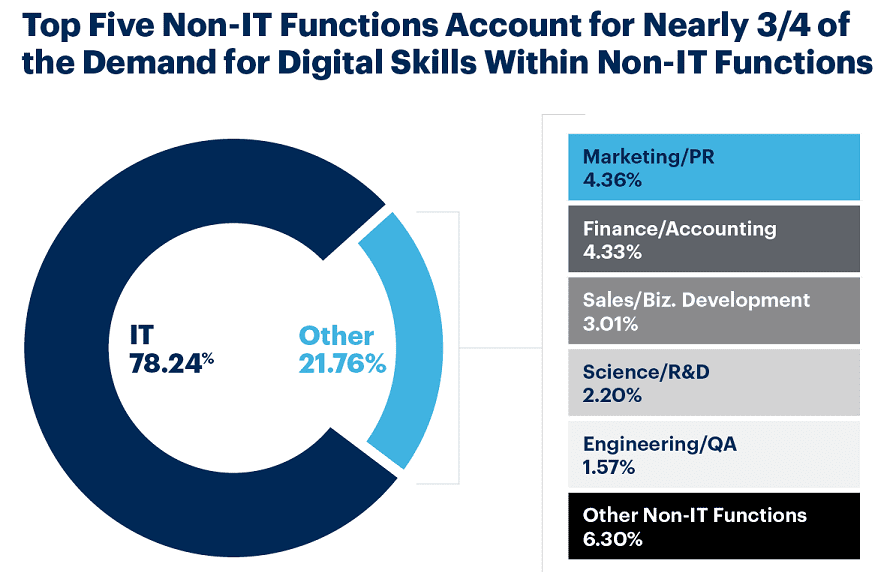Future-Ready Workforce
Over the past two years, the world of work has undergone a rapid transformation – from the Great Resignation to the Great Reshuffle, and now the Great Comeback. The only constant that has remained is talent – which is now more valuable than ever.
In the talent economy, companies that leverage the best talent can navigate these uncertain challenges better and emerge stronger and more resilient.
As industries continue to undergo digital transformation post the disruption caused by the pandemic, the demand for a highly skilled digital workforce will only continue to increase. And it is not just the IT (Information Technology) vertical that needs a digital-ready workforce, other functions such as marketing, sales, finance, and even human resources (HR) are witnessing a significant rise in demand.

According to Gartner, these five corporate functions accounted for half of the demand for digital skills in non-IT roles in 2021.This has also led to demand for talent with digital skills skyrocketing, be it new-age technology businesses or traditional businesses.
This is especially the case for high in-demand skills in fields such as engineering where attrition has skyrocketed. According to McKinsey, companies can accelerate their digital transformation by 20 to 30 per cent by hiring top engineering talent who can be three to ten times more productive than the firms that hire an “average” engineer
PeopleStrong and Economic Times recently spoke with top industry leaders on their perspectives when it comes to building a future-ready workforce and how technology can fit into the picture.
Here’s what industry leaders had to say about the need for a digital workforce

Rabeen Singh | CHRO, Tata Advanced Systems
“The industry today is evolving much faster than it has in the past. This has led to a gap in the supply of traditional vs. digital/technological skill sets required to address its growing needs.
In our efforts to address this challenge of building a digitally ready workforce, we need to focus on two aspects. First, a top-down approach for driving and defining the ‘digital culture.’ Second, the need to assess current and prospective talent on the softer aspects of agility and passion for learning.”

Joy Banerjee | Group Head – HR, IL&FS Group
“Talent development and employee engagement are now weaved into one single approach which helps in carving out development and career paths. The emphasis is now on a holistic approach to organizational goals and individual development.
This helps in having employees engaged while setting a path for career progression. A future-ready workforce can be the key differentiator in today’s talent economy.”

Ritu Sinha | Head – HR, Akasa Air
“To build a high-impact digital-ready workforce, we need to automate some critical HR processes and invest in the right digital talent management practices. These will enhance HR efficiency, performance, and customer experience. However, working with these new digital platforms and applications and managing new business processes is not easy, especially since all of these processes need to be learnt at short notice and deliver results.
We also need to upskill our employees and managers to use these processes and become familiar with its application so that they can take advantage of these efficiently.”
Talent Acquisition
Many companies of late have been aligning their talent acquisition strategy to adjust to new ground realities.
With the war for talent intensifying, organizations have realized there is more to attracting talent than just compensation or work perks. Today’s workforce, especially the GenZ and the Millennials demand learning opportunities, career growth, and a healthy work-life balance.
Training and reskilling the existing workforce have now become an essential element of an organization’s talent strategy if they want to gain an edge over their competition. McKinsey also found that 82 percent of executives expect reskilling and upskilling to mitigate talent shortages necessitating massive investments from organizations over the next decade.
Here’s what people leaders from the industry had to say about Talent Acquisition

Ritu Sinha | HR Head, Akasa Air
“Finding the correct talent for an organization is not a one-time process, but a continuous process of planning, forecasting, networking, and building relationships.
Hiring is about immediate filling of vacancies whereas acquiring talent requires planning ahead to fill these vacancies in future – which is needless to say, more efficient, and productive. The HR team of the future needs to make a shift towards talent acquisition and work ahead of time to identify the positions which will be difficult to fill, when a sudden requirement arises.”

Rabeen Singh | CHRO, Tata Advanced Systems
“In order to tap into the limited talent pool, the company’s strategy should be focused on continuously building the employer brand, with a focus on an open and collaborative culture where each individual is provided with a diverse, inclusive, equitable, and conducive work environment to contribute, upskill, and grow in their career.
Additionally, companies should provide candidates with a seamless, and transparent experience, which will enhance the opportunity to attract the best talent.”

Shashikant Patange | Director – HR (India & SEA), Linde Engineering
“Employers need to keep a close watch over the market dynamics. The focus should be on upskilling and building a talent pipeline through rigorous hiring and talent development process. With the market open to a lot of opportunities, employers face a bigger challenge in retaining people.”

Ruhie Pande | CHRO, Godrej Housing Finance & Godrej Fund Management
“Workplaces today, across any industry, have a shot at thriving only if they are digital-first. And the pandemic only made this more evident. Studies have shown that contrary to the preconceived notions that a person’s age, race, class, or gender influence their ability to use technology, it is the digital attitude which supersedes everything else.
So, I believe that the first step towards building a digital-ready workplace is to hire the right set of people, those who possess a positive digital attitude or those who can be trained and coached to adopt technology as a way of life.”
Talent Upskilling
In a rapidly evolving business landscape, employees with specialized skills have the upper hand in the employee-employer relationship.
Talent development refers to organizational initiatives that enable employees to build upon existing skills while identifying new skill development opportunities which help achieve organizational goals.
Leading organizations, such as Amara Raja, use our PeopleStrong Talent OS to give a boost to their talent initiatives.
With PeopleStrong Talent OS, organizations can build high-performing teams that can help them navigate challenges in an uncertain external environment. Whether recruiting the best with advanced sourcing capabilities, creating a performance-centric team culture, or crafting personalized learning paths for their employees based on their skills – they can use its features to get ahead in the talent war.
Here is what people leaders from the industry had to say about managing talent

Shashikant Patange, Director – HR (India & SEA), Linde Engineering
“We, as HR professionals, should set the platform for our leaders to closely connect with their employees and partner with them in the development journey. While meeting the company-level KPIs and OKRs are important, leaders need to help employees develop their individual development plans and constantly engage them.”

Joy Banerjee, Group Head – HR, IL&FS Group
“The organisation’s growth story has to be closely woven with the individual development; along with this, it’s critical to have an environment that allows innovation and sharing of best practices.
This would allow employees to find purpose and meaning in their roles. Added to this, the ease of working and non-constricted, time-bound or space-bound workspaces would only make it better.”

Alok Sheopurkar, HR Head, HDFC Asset Management
“Organisations will have to look at the organisation as a subset of the society and design their vision, mission, purpose, support system, welfare agenda or engagement agenda in line with being part of the society at large.”
Employee Lifecycle Management
Employee lifecycle can be classified into five phases: recruitment, onboarding, development, retention, and exit. Employee experience (EX) is the sum of all these experiences, which companies are now focusing on improving.
Research by McKinsey shows that people who report having a positive employee experience have 16 times the engagement level of employees with a negative experience, and that they are eight times more likely to want to stay at a company.
A study by HBR also points out how a solid EX can boost a company’s bottom line, thus making it paramount for companies to put it at the heart of their people strategy not just to gain better business outcomes but also better people outcomes.

Here is what people leaders had to say about EX

Nishigandha Kulkarni, CHRO, Wellness Forever Medicare
“Being a pharmaceutical business, we have been fast to adopt digitally driven processes and infrastructure to drive efficiency. This is seen in the infrastructure deployed in our centralised logistics, fulfilment, and distribution.
We lay a big emphasis on training our employees to work with these technologies and have adopted an audio-visual format for training and development, especially considering the remote nature of learning in today’s technology-driven world. Our internal app i.e., Lamp, is an online learning portal that drives seamless learning, sharing of updates, and dissemination of training modules as well as performance tracking.
This experience also helped us drive our meetings, presentations, and all Closed-loop Learning (CLL) initiatives online. We also automated our talent management and operations using a HRMS platform that helps us manage compliances online in a more collaborative and transparent manner.”

Rabeen Singh, CHRO, Tata Advanced Systems
“Employee experience directly impacts a company’s bottom line. Monotonous, repetitive, and transactional work tends to disengage employees.
Technologies like AI and ML can help increase collaboration, transparency, and make the decision-making process more efficient while freeing up the bandwidth of employees to focus on more strategic and innovative ideas which can enhance customer experience, which in turn will increase the clientele and boost the company’s revenues and profits.
Data analytics can add lots of engaging insights for employees to validate their ideas and move faster in their development process.”
HR Technology
$261,792.68.
That is what it will cost an average employer of 500 people if they do not equip employees with the latest HR technology, according to a detailed study by Ernst & Young.
The right HRMS suite can address a slew of pain points such as recruiting, onboarding, core HR, learning, payroll, performance, succession planning and more while letting you focus on your core expertise.
Here is what people leaders had to say about the need for HR Technology

Alok Sheopurkar, HR Head, HDFC Asset Management
“When it comes to HR tech, people want to offer the best services. More and more HR leaders and managers want one thing in common that is providing the best HR services. People are willing to invest money because the last thing they want is an administrative hassle for their employees.
So, cost-benefit ratio, keeping employees happy, and ensuring that they do not get into any trouble because of the poor tech infrastructure is going to be extremely critical going forward.”

Ruhie Pande, CHRO, Godrej Housing Finance
“The pandemic has certainly accelerated the adoption of HR tech. Hybrid working has demanded that all critical processes be migrated to a digital platform. We are already seeing that the use of analytics, AI and ML are marrying key HR processes to provide more meaningful outcomes.
Technology and AI will continue to play a key part in engaging with candidates from the start of the hiring and selection process to handholding in the onboarding phase. HR Analytics, in terms of measuring new human capital metrics and the emergence of the HR Data Scientist, may be a hot skill soon.”
Conclusion
We are in an era of accelerated digitization and for companies to build a workforce for the future – there are a slew of factors that companies need to execute with various stakeholders including people leaders, management, and employees.
PeopleStrong’s AI-powered, comprehensive, integrated Talent Operating System could be just the solution that you are looking for to win this talent war.
An Integrated Talent Management Suite can help you:
- Create a seamless hiring experience that both your recruiters and candidates will love and results in 50% higher offer acceptance than industry standards
- Create a fully automated, hyper-personalized onboarding experience that reduces 50% joining time
- Build an efficient and high-performance culture to unleash the true potential of your workforce
- Craft personalized career and skill advancement paths for employees
- Leverage powerful insights from real-time talent analytics towards better talent decisions with agility, and at scale
If you are building a future-ready workforce at your organization and would like to get a demo of PeopleStrong Talent Management, feel free to reach out to us here.
Read more by downloading the e-book









